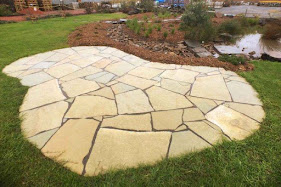Although bluestone's dense and tough properties make it a trendy choice for interior and exterior bluestone pavers, Melbourne projects, this can be very detrimental to the appearance of the stone, especially if the stains remain for an extended period ooze and penetrate further into the surface of the pavers.
Use this guide to remove stains as soon as you see them.
- It's a great concept to have high-pressure cleaning Bluestone tiles in Melbourne every year. High-pressure in washing the pavers and removing much of the natural material that develops between the pavers. Removing the organic material will reduce the number of insects in the area and allow the solid to adhere.
- Check paver joints for sand leakage. If the sand is more than ¼ inch below the grout surface, consider "re-sharpening" the pavers, and you will need to use sand to re-grind. After setting, bluestone tiles in Melbourne and re-sanding the pavers, it is necessary to deal with an excellent quality seal. Sealing your pavers protects against maximum contamination and hardens the bonding sand, locks in and prevents anthills and weeds from forming between the pavers.
- A good quality sealer will prevent the formation of surface haze caused by moisture in the patch during sealing. If you currently see smoke from an old sealer on the floor, you must remove the existing sealer before using a new sealer.
- It would help if you always began with a thorough cleaning of your bluestone pavers. You never know when this simple method will remove this annoying stain. Use a neutral cleaner made specifically for natural stone, a unique stone soap, or a mild liquid detergent. Put this in a bucket of warm water and apply the solution to the pavers with a mop or soft cloth.
- If a simple cleaning has not removed the stains your bluestone has developed, one of these methods should suffice. These are pinkish-brown spots caused by coffee, fruits and leaves on the bluestone surface. Remove the interfering material on the external surfaces and let the sun fade the stain. On interior surfaces, use a solution of water, a few drops of ammonia, and about 12 per cent hydrogen peroxide to remove the stain.
Stains are also of different types, below mentioned are a few of them:
- Ink - These stains on lighter bluestone can be removed with bleach or hydrogen peroxide. To remove stains from darker stones, use lacquer thinner or acetone.
- Biological- These spots are caused by powdery mildew or algae growth; you must kill the bacteria on the bluestone to remove it effectively. Use half a cup of ammonia, bleach, or hydrogen peroxide diluted with water (use just one and never mix these chemicals).
- Metallic - These stains are difficult to remove and are caused by rusty furniture penetrating the bluestone beneath. To remove the colour, you may need to mix an envelope.
Regardless of the density and hardness of bluestone tiles in Melbourne, they can still be coloured if not handled or cared for correctly. If you notice that your stone has been stained from a spill or weathering, try one of the techniques above to remove it and restore your bluestone pavers Melbourne to their former glory.

Comments
Post a Comment